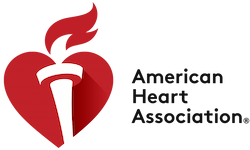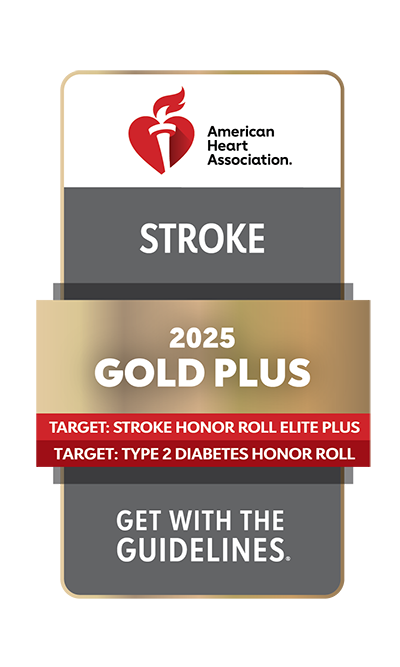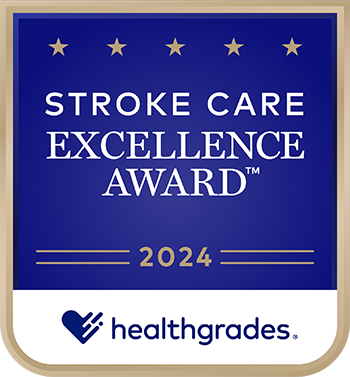Emergency stroke treatment in the Inland Empire
Riverside Community Hospital is home to a Comprehensive Stroke Center, certified by DNV GL Healthcare. This means that our emergency specialists offer 24/7 emergent diagnostic and treatment services for patients experiencing any type of stroke. Our dedicated stroke team includes trained physicians and nurses who work together to identify stroke symptoms and provide a care plan as quickly as possible.
A stroke is a major medical emergency. If you suspect someone is having a stroke, dial 911 immediately.
Recognition




Riverside Community Hospital is certified by DNV GL Healthcare as a Comprehensive Stroke Center. We are also recognized by The American Heart Association for excellence in stroke care. These designations signify our dedication to quick and effective stroke care.
What is a stroke?
A stroke occurs when an area of the brain is deprived of blood flow. Similar to how a heart attack is a lack of blood flow to the heart, a stroke is an interruption in blood flow to the brain. According to the Centers for Disease Control and Prevention (CDC):
- About 795,000 Americans experience a new or recurrent stroke each year.
- Every four minutes, someone dies of a stroke.
- On average, a stroke occurs every 40 seconds.
- Leading cause of disability in the United States
- Up to 80 percent of strokes can be prevented.
Riverside Community Hospital's stroke specialists work hard to improve stroke statistics with help from our other healthcare teams and the American Heart Association and American Stroke Association.
Signs of a stroke
Every second counts when it comes to effective stroke care. That's why it's important to understand the signs and warnings of stroke and get to the hospital fast if they appear. If you suspect a stroke is occurring, remember the acronym: B.E. F.A.S.T.
- B(alance)—Does the person have a sudden loss of balance?
- E(ye)—Has the person lost vision in one or both eyes?
- F(ace)—Ask the person to smile. Does one side of the face droop?
- A(rms)—Ask the person to raise both arms. Does one arm drift downward?
- S(peech)—Ask the person to repeat a simple sentence. Are the words slurred? Is the person confused? Can they repeat the sentence correctly?
- T(ime/errible Headache)—If you notice a person having these signs and symptoms you need to call 911 immediately. Furthermore, a sudden and severe headache often described as the worst headache you’ve ever had.
Additional stroke symptoms include:
- A sudden loss of strength or sensation in the face, arm or leg, or a combination of the three
- Dizziness and clumsiness
- Nausea
- Vomiting
Types of stroke we treat
Our dedicated stroke team is prepared to treat all kinds of stroke. The three main types of stroke include:
Ischemic stroke
An ischemic stroke is the most common type of stroke. Ischemic strokes occur when an artery that supplies the brain is greatly narrowed or blocked. This can be caused by a buildup of plaque in the arteries or from a blood clot in the arteries. Plaque in the arteries can break off in small pieces, or the rough edges can cause blood clots that eventually break free and become stuck in small blood vessels in the brain.
Hemorrhagic stroke
Hemorrhagic strokes are less common and occur less frequently than ischemic strokes. However, they are responsible for 30 percent of all stroke deaths. Instead of a blockage, hemorrhagic strokes occur when a blood vessel in the brain ruptures, allowing blood to flow freely into the skull and brain tissue. This blood flow causes damage to the brain cells.
Transient ischemic attacks (TIA)
TIAs are often called "mini strokes" and leave no permanent brain tissue damage. TIAs are temporary blockages of the artery. The symptoms of the TIA go away within 24 hours, depending on which artery is blocked.
When TIA is treated in an emergency room (ER), it is often treated the same as a stroke because the symptoms can be very similar. TIAs are warning signs, as more than 30 percent of patients who experience TIAs ultimately have strokes so they must be taken very seriously.
Our stroke diagnostics
Stroke treatment may begin with our emergency medical service workers in the field. By the time a patient arrives at our ER, our stroke team is ready for them.
The signs and symptoms of stroke can be similar to other conditions. That's why, when patients come to our ER with stroke symptoms, our physicians perform diagnostic tests to determine a treatment pathway.
Our stroke treatments
After we diagnose a stroke or a neurological event or disorder, we offer fast and effective treatments including dissolving or removing the blockage, or coiling, which helps blood flow diversion.
What should I expect when I arrive at the hospital?
Emergency Room:
When you arrive at the emergency room, hospital staff will quickly evaluate your condition and determine the best treatment for you. Things will move fast, but our medical team will explain what is happening during every step of the process.
The key question for you or your family will be, “When was the last known well time?” We need to know the last time you last felt symptom free before the stroke. It’s an important question because it helps the medical team determine the type of treatment for you.
You’ll undergo a computed tomography (CT) scan to see if the stroke is caused by a blocked blood vessel or a burst vessel. The CT scan can also determine the type of medication doctors should use to treat the stroke.
After the CT is finished, you will speak with the physician about the medication and treatment options. If the last known well time is less than 4.5 hours, you might be able to take clot-dissolving medication. If a clot is in an area where surgery can remove it, you may undergo a mechanical thrombectomy, which can remove the clot safely through a small incision.
During your stay in the ER, we’ll also record your weight and take some blood to see if there is anything else they may need to address. We’ll also check your blood sugar and blood pressure.
Until we can evaluate the effects of the stroke, you can’t have any food, water or medications until a nurse says it’s ok. After they give their approval, a speech therapist will see you to make sure you are eating and drinking as safely as possible.
Intensive Care Unit:
Sometimes, you may be admitted to the intensive care unit (ICU), where the medical team is trained to care for patients who have a stroke. If you received clot-busting medication or underwent a procedure for a stroke, you will also be admitted to the ICU.
While in the ICU, staff will monitor you closely for any changes in your condition, and you’ll receive further treatment. We may order more tests to help your medical team plan your care. Pastoral services are available if you and your family need it.
G6 Neuro/Telemetry:
When you are medically stable, we may transfer you to our Neuro Telemetry Unit. Here, highly skilled nurses will care for you and ensure that everything is ready before you leave the hospital. Your physician and nurses will answer all questions and will give you a stroke patient education book.

Stroke risk factors
There are many risk factors for stroke, and most of them can be managed. Our dedicated providers are here to help you reduce your risk for stroke. Some of the risk factors for stroke include:
- Age
-
Cardiovascular conditions and events, such as:
- Atrial fibrillation
- Carotid or other artery diseases
- Heart attack
- Heart disease
- High blood pressure
- High cholesterol
- Certain blood disorders
- Diabetes mellitus
- Excessive alcohol intake
- Family history of stroke
- Gender
- Illegal drug use
- Obesity
- Physical inactivity
- Poor diet
- Prior history of stroke or TIA
- Race
- Sleep apnea
- Tobacco use
High blood pressure and stroke
Normal blood pressure is below 120/80. Most people who have strokes have high blood pressure. However, according to the CDC, nearly one in five Americans do not know they have high blood pressure.
On average, people who are 50 years old or older with high blood pressure have life expectancies five years shorter than people without high blood pressure. That's why it's important to have your blood pressure checked and keep it in check to reduce your risk of stroke.
High cholesterol and stroke
Since most strokes are caused by a buildup of fat, cholesterol and other substances called plaque in the inner walls of your arteries, these medications are used to help reduce further buildup. Our providers here at Riverside Community Hospital are dedicated to helping you obtain your cholesterol levels and helping you manage new goals for your future.
Blood sugar and stroke
Having too much sugar in your blood can be very bad for the arteries in your brain which can increase your risk for stroke. Too much sugar in your blood vessels can cause arteries to stiffen and increase the buildup of fatty deposits. Certain medications can help aid in lowering blood sugar, including injectable insulin or pill form medication.
Stroke recovery and aftercare
We guide our patients from stroke diagnosis through recovery. After we treat a patient with stroke, the recovery process includes:
- Inpatient stroke rehabilitation (rehab), which may include:
- Occupational therapy
- Physical therapy
- Speech therapy
- Post-discharge rehab, which may include:
- Caregiving support
- Outpatient rehab
- Home health assessments
Preventing future strokes
After a patient has a stroke, the risk of suffering another stroke increases. That's why it's important for patients to eat a healthy diet, take medications as directed and follow-up with a primary care physician to manage risk factors.
Stroke support groups and education
If you or someone you know is a survivor of stroke or interested in our free stroke awareness and prevention lectures, call our Consult-A-Nurse® team at (951) 788-3463 to find out about our upcoming support groups and community events.